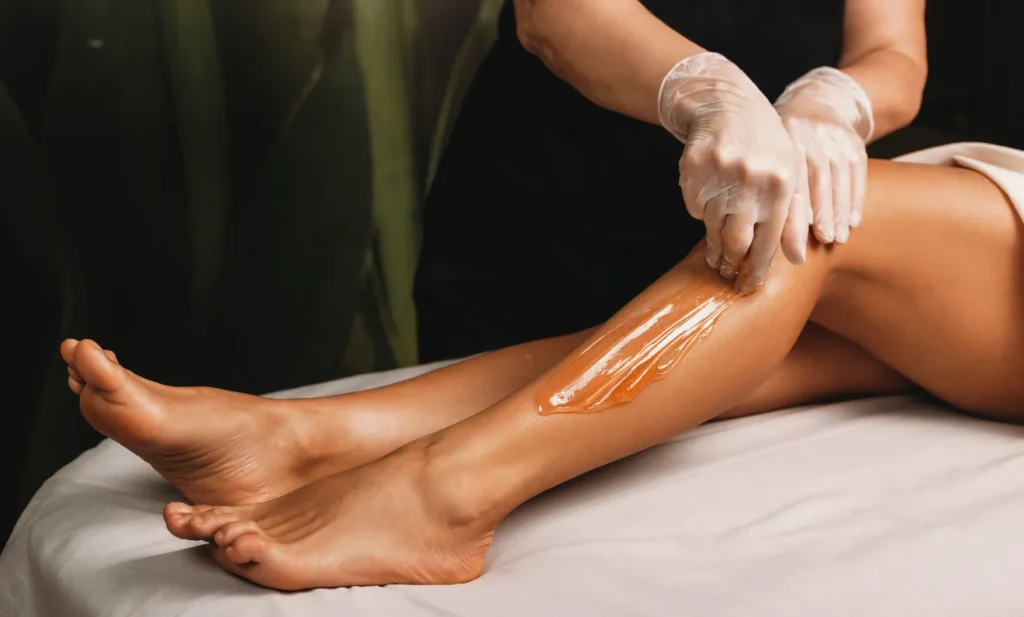Waxing involves applying hot or cold wax to the skin and then removing it along with the unwanted hair. The process is known for providing longer-lasting results compared to shaving or using depilatory creams. Depending on the speed of your hair growth, regular waxing can keep your skin smooth for several weeks.
When it comes to waxing, there are different types of waxes that can be used. Some salons offer traditional hot wax, which is heated and then applied to the skin using a spatula. This type of wax is known for its ability to grip the hair firmly, making it ideal for coarse or stubborn hair. On the other hand, there is also cold wax, which comes in pre-made strips. Cold wax is convenient and can be used at home, but it may not be as effective in removing all the hair.
Regardless of the type of wax used, the process of waxing involves spreading a thin layer of wax onto the skin in the direction of hair growth. A cloth strip or paper strip is then pressed onto the surface of the wax and quickly pulled off in the opposite direction of hair growth. This pulling motion removes the hair from the root, resulting in a smoother appearance and texture on the waxed area.
The Basics of Waxing
Waxing removes hair from the root, which means it takes longer for new hair to grow back compared to other hair removal methods. When the hair follicle is pulled out, it takes time for the hair bulb to regenerate, resulting in a smoother appearance and texture on the waxed area. Regular waxing can weaken hair follicles over time, leading to finer regrowth.
One of the advantages of waxing is that it can be done on various parts of the body. From the eyebrows to the legs, waxing can effectively remove unwanted hair from different areas. However, it’s important to note that some areas may be more sensitive than others. For example, the bikini area and underarms tend to be more sensitive, so it’s crucial to choose a wax that is suitable for these areas and to follow proper aftercare instructions to minimize any discomfort or irritation.
Factors Influencing Waxing Frequency
The frequency at which you should get waxed depends on various factors. One of the primary factors is how quickly your hair grows. People with faster hair growth cycles may need to wax more frequently than those with slower cycles. Additionally, the density and thickness of your hair play a role. Coarser hair may require more frequent waxing compared to finer hair.
Another factor to consider is the stage of hair growth. It’s recommended to wait until the hair is at least a quarter of an inch long before waxing. This ensures that the wax has enough hair to grip onto for effective removal. If the hair is too short, the wax may not be able to grab onto it properly, resulting in incomplete hair removal.
Furthermore, the area being waxed can also influence the frequency of waxing. Some areas, such as the face or underarms, may require more frequent waxing due to faster hair growth. Other areas, like the legs or arms, may have slower hair growth, allowing for longer intervals between waxing sessions.
It’s worth noting that regular waxing can lead to a reduction in hair growth over time. As the hair follicles are repeatedly pulled out from the root, they can become weaker, resulting in finer and sparser regrowth. This means that with consistent waxing, you may find that you need to wax less frequently in the long run.
Understanding the basics of waxing and the factors that influence waxing frequency can help you make informed decisions about your hair removal routine. Regular waxing in Fort Collins can keep your skin smooth and hair-free for extended periods, providing you with the confidence to flaunt your silky-smooth skin.
The Role of Hair Growth Cycles in Waxing
Understanding hair growth cycles is crucial when determining your waxing frequency. Hair grows in cycles, with different hair follicles at different stages of growth at any given time. There are three main phases of the hair growth cycle: anagen (active growth), catagen (transition), and telogen (resting or shedding).
An Overview of Hair Growth Cycles
The anagen phase is when the hair is actively growing. This phase typically lasts anywhere from two to six years, depending on the individual. During this phase, the hair follicle is nourished by blood vessels, which provide essential nutrients for hair growth. The rate of growth during the anagen phase can vary, with some individuals experiencing faster hair growth than others.
Following the anagen phase, the catagen phase signals the end of active growth. This transitional phase lasts for a few weeks and is characterized by the hair follicle shrinking and detaching from the blood supply. While the hair is no longer actively growing during this phase, it is still firmly rooted in the follicle.
Finally, the telogen phase is when the hair rests and eventually sheds to make room for new hair. This phase lasts for approximately three to four months. During the telogen phase, the hair follicle is in a dormant state, and the hair is no longer attached to the blood supply. Eventually, a new hair begins to grow, signaling the start of a new hair growth cycle.
How Hair Growth Cycles Affect Waxing
Since waxing removes hair from the root, it’s most effective during the anagen phase when the hair is firmly rooted in the follicle. The wax adheres to the hair and pulls it out from the root, resulting in longer-lasting smoothness. However, not all hairs are in the anagen phase simultaneously.
This is why it’s important to establish a regular waxing schedule to catch hairs in the anagen phase for optimal results. By consistently waxing at regular intervals, you increase the chances of targeting a higher percentage of hairs in the active growth phase. Over time, consistent waxing can synchronize hair growth cycles, leading to longer periods between waxing sessions.
It’s worth noting that individual hair growth patterns can vary, and factors such as hormonal changes, genetics, and overall health can influence the duration of each hair growth phase. Additionally, certain areas of the body may have different hair growth cycles, resulting in varying waxing frequencies for different body parts.
Understanding your hair growth cycles and working with a professional esthetician can help you determine the most suitable waxing schedule for your individual needs. By taking into account the different phases of hair growth and targeting the anagen phase, you can achieve smoother, longer-lasting results from your waxing sessions.
Different Body Parts, Different Waxing Schedules
When it comes to waxing, different body parts have different needs. The frequency of waxing for facial hair may differ from waxing other areas of the body.
Waxing is a popular method of hair removal that offers longer-lasting results compared to shaving or using depilatory creams. It involves applying hot or cold wax to the skin and then removing it along with the unwanted hair. While waxing can leave your skin smooth and hair-free, it’s important to establish a waxing schedule that suits each specific body part.
Waxing Frequency for Facial Hair
Facial hair tends to grow faster than hair on other parts of the body, especially for individuals with hormonal imbalances. This can result in more frequent waxing for areas like the eyebrows, upper lip, and chin. It’s recommended to establish a schedule and maintain it to keep your facial hair in check and maintain a well-groomed appearance.
When it comes to eyebrow waxing, it’s crucial to find a skilled esthetician who can shape your brows according to your facial features. Regular waxing every two to three weeks can help maintain the desired shape and keep stray hairs at bay.
The upper lip is another area where frequent waxing may be necessary. Hair growth on the upper lip can be noticeable and bothersome, especially for those who prefer a smooth and hair-free look. Waxing every three to four weeks can help keep the upper lip area smooth and hairless.
Chin hair is a common concern for many individuals, particularly women. Waxing the chin area every two to three weeks can help remove unwanted hair and prevent it from becoming more noticeable.
Waxing Frequency for Body Hair
For body hair, waxing frequency varies depending on personal preference and hair growth rate. Areas such as the legs, underarms, and bikini line may require waxing every three to six weeks. However, it’s essential to listen to your body and adjust the frequency based on how quickly your hair regrows and your desired level of smoothness.
Leg waxing is a popular choice for those who want to achieve long-lasting smoothness. The frequency of leg waxing can vary depending on factors such as hair growth rate, thickness, and personal preference. On average, waxing every four to six weeks can help maintain smooth and hair-free legs.
Underarm waxing is another common practice for individuals who prefer hair-free underarms. The frequency of underarm waxing can range from every two to four weeks, depending on how quickly your hair regrows and your desired level of hairlessness.
When it comes to the bikini line, a bikini wax is a popular choice for achieving a clean and hair-free look. The frequency of bikini waxing can vary depending on factors such as hair growth rate of the pubic hair, personal preference, and the style of bikini you prefer. On average, waxing every three to six weeks can help keep the bikini line smooth and hair-free.
It’s important to note that everyone’s hair growth rate is different, and what works for one person may not work for another. It’s recommended to consult with a professional esthetician who can assess your hair growth pattern and recommend the ideal waxing schedule for each specific body part.
Personal Factors that Determine Waxing Frequency
In addition to hair growth cycles and body parts, personal factors such as skin and hair type can influence how often you need to get waxed.
Your Skin Type and Waxing
If you have sensitive skin, you might need to space out your waxing sessions to allow your skin to recover between appointments. On the other hand, those with normal or less sensitive skin may be able to withstand waxing more frequently without experiencing adverse effects. It’s crucial to monitor your skin’s response and adjust your waxing treatment schedule accordingly.
Your Hair Type and Waxing
The texture and density of your hair can also impact your waxing frequency. Coarse or thick hair may require more frequent waxing, whereas fine or thin hair may allow for longer periods between sessions. Pay attention to how your hair regrows and adjust your waxing schedule to align with your hair type.
Professional Recommendations for Waxing Frequency
Experienced estheticians can provide valuable insights into the recommended schedule for waxing in Fort Collins based on their experience and expertise.
What Beauty Professionals Say
Beauty professionals typically suggest starting with more frequent waxing sessions to allow your hair growth cycles to sync up. From there, you can adjust the frequency based on how your skin and hair respond. Regular check-ins with your esthetician or waxing specialist can help fine-tune your schedule for optimal results.
Tips for Maintaining Your Waxing Schedule
Once you’ve established your ideal waxing frequency, it’s essential to maintain it to reap the benefits that waxing offers. Here are a few tips to help you stay on track:

